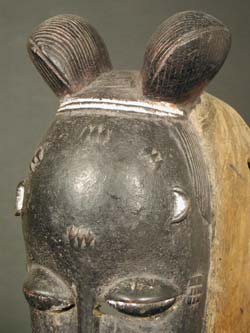Southern Guro Wooden Mask, 20th Century CE
Wood, paint
5.375 x 11.75
PF.5501 (LSO)
Further images
This impressive mask was made by the Guro, a group sandwiched between the Baule, We, Bete and Malinke, on the Ivory Coast. Their artworks display influences of all these groups...
This impressive mask was made by the Guro, a group sandwiched between the Baule, We, Bete and Malinke, on the Ivory Coast. Their artworks display influences of all these groups as well as some uniquely Guro characteristics. The current mask is elongated yet deep, with a good gloss patina on the rear section which was used to support the accompanying costume. The face is anthropomorphic, but with animal characteristics of the mouth and the eminences on the apex of the head. The eyes are heavily lidded, the nose long and thin. The ground is dark painted, and decorated further with keloid scarifications on the forehead and cheeks and highlights of white paint.
The Guro were originally known as the Kweni but were renamed the Guro by the French who colonised their homeland in the early 20th century. They are renowned for the elegant and highly finished nature of their works, especially masks, of which there are various types that are further subdivided into the Western, Southern and Northern styles. The current mask is an example of the Southern style.
Southern masks had a number of roles, and were often horned. Some of them were used for the funerals of important men, and could not be seen by women. The most notable examples were used for judicial purposes, although they also served an apotropaic function. Most good examples are heavily worn, implying that their importance and severity increased by association with many “judges” over the years.
This is a superb example of the genre and a good addition to any collection or sophisticated domestic setting.
The Guro were originally known as the Kweni but were renamed the Guro by the French who colonised their homeland in the early 20th century. They are renowned for the elegant and highly finished nature of their works, especially masks, of which there are various types that are further subdivided into the Western, Southern and Northern styles. The current mask is an example of the Southern style.
Southern masks had a number of roles, and were often horned. Some of them were used for the funerals of important men, and could not be seen by women. The most notable examples were used for judicial purposes, although they also served an apotropaic function. Most good examples are heavily worn, implying that their importance and severity increased by association with many “judges” over the years.
This is a superb example of the genre and a good addition to any collection or sophisticated domestic setting.









